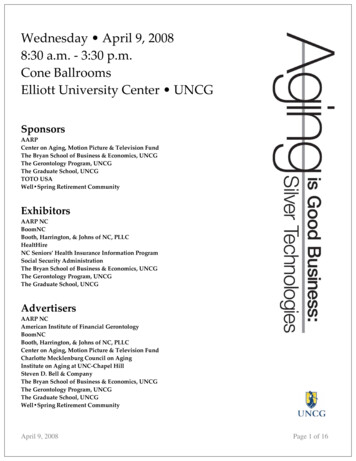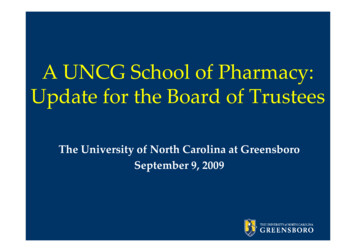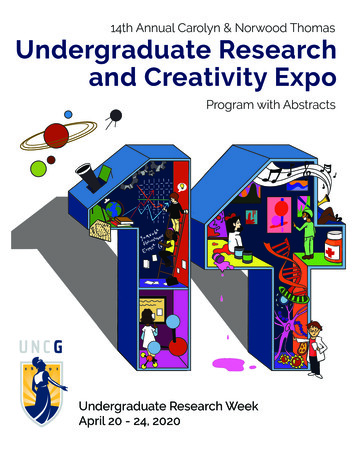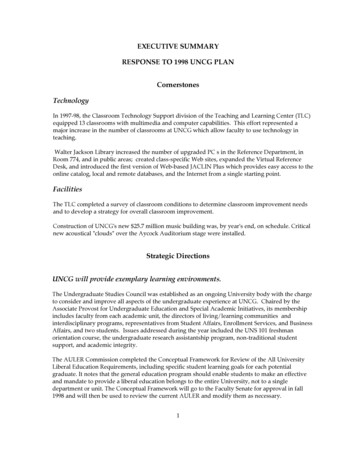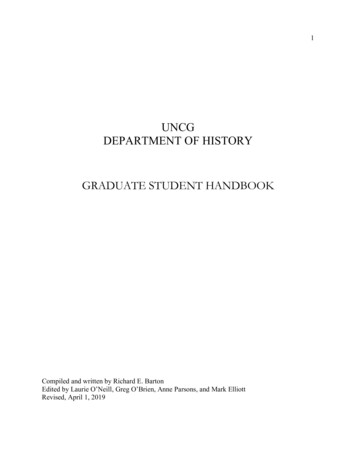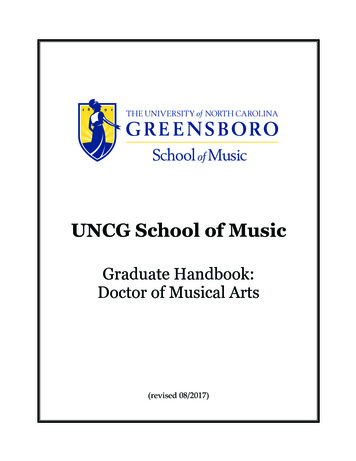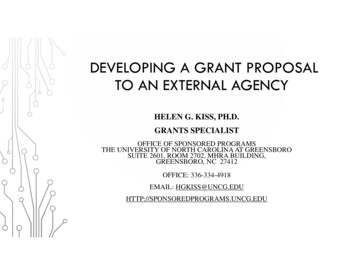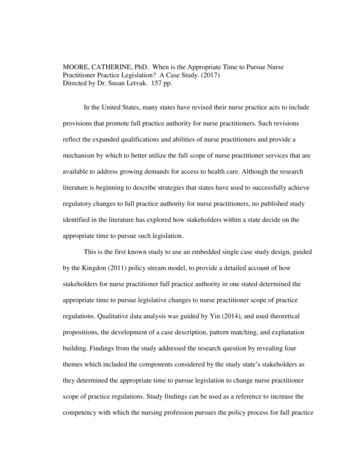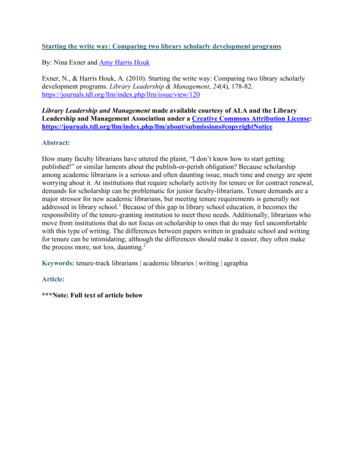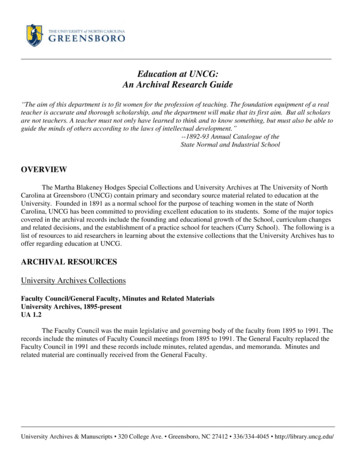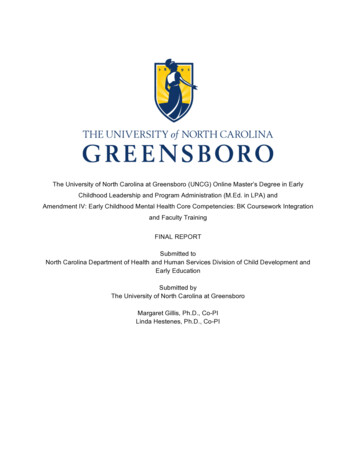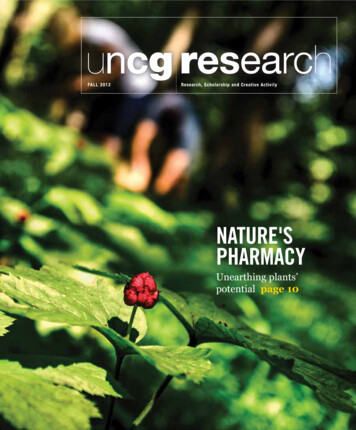
Transcription
uncg researchfAL L 2012research, scholarship and creative ActivitynaTure'SPharmacyUnearthing plants’potential page 10
uncg researchFA L L 2 0 1 2 VOLUME 10UNCG Research is published byThe Office of Research and Economic DevelopmentThe University of North Carolina at GreensboroPO Box 26170Greensboro, NC 27402-6170336.256.0426Vice Chancellor for Research and Economic DevelopmentDr. Terri SheltonExecutive AssistantDebbie FreundAssociate Vice Chancellor for University RelationsHelen Dennison Hebert ’97 MAEditorBeth English ’07 MALSArt DirectorLyda Adams Carpén ’88, ’95 MALSPhotography EditorChris EnglishAssistant EditorMike Harris ’93 MAContributing WritersBrian ClareyLanita Withers GoinsMichelle HinesDawn MartinStephen MartinJeri RoweKhalisa WilliamsContributing DesignersMark UnrueEric Peterson, Stir CreativeContributing PhotographerDavid WilsonResearch Advisory CouncilDr. Terry AckermanAssociate Dean of Research and Assessment,School of EducationDr. Joyendu BhaduryAssociate Dean for Graduate Programs and Research,The Bryan School of Business and EconomicsMichael CrumptonAssistant Dean for Administrative Services, University LibrariesDr. Bill DudleyAssociate Dean for Research, School ofHealth and Human SciencesDr. Valera FrancisDirector, Office of Sponsored ProgramsDr. Vincent HenrichDirector, Center for Biotechnology, Genomics and Health ResearchDr. Don HodgesDirector, Music Research InstituteDr. Julia Jackson-NewsomSpecial Assistant for University Research Projects,Office of Research and Economic DevelopmentDr. Tom KwapilAssociate Dean for Research, College of Arts and SciencesDr. Wendy McColskeyProgram Director, SERVEDr. Chris PayneDirector, Center for Youth, Family and Community PartnershipsDr. Debra WallaceAssociate Dean for Research, School of NursingDr. Bill WienerDean, The Graduate Schoolt h e P u b L icAt io n o f t h is is s u e coincides with the launchof uncg’s new integrated marketing campaign and tagline Dosomething bigger altogether. uncg is truly a community wherethe contributions of our students, faculty and staff make animpact far beyond our campus.doing something bigger altogether can mean many things.At its core, it evokes community – accomplishing somethingin collaboration that one could not accomplish alone. uncg’slongstanding history of engaged scholarship is reflected in themutually beneficial partnership of dr. bob Wineburg and odell cleveland and the Welfarereform Liaison Project. since 1997, the project has focused on helping people movetoward self-sufficiency through job training and placement. More than 1,000 people withcumulative earnings of more than 10 million is clearly something bigger. the initiativenot only transforms lives but, through this unique collaboration, is an economic engine aswell. in a similar vein, the work of dr. Joy bhadury in operations, logistics and supply chainmanagement and operations research applications has been applied to more than 15 publicand private organizations, demonstrating that universities can be an economic driver.the tagline also reflects the innovation that can stem from collaboration betweenfaculty and students. the design work of dr. Patrick Lee Lucas and his students for theindustries of the blind highlights not only why dr. Lucas won the 2011 unc board ofgovernors Award for excellence in teaching but also the value of student expertise inaddressing community needs.the teamwork in research and intervention to Alleviate disparities (triAd) Projectis one of the best examples of faculty doing something bigger altogether in concert withpartners in the community. initiated in 2003 and based in the school of nursing, the goalis to address the major health disparities of African-Americans, hispanics/Latinos, andlow-income children and adults in central north carolina by harnessing expertise andcreating partnerships among faculty and students in nursing; public health education;kinesiology; anthropology; mathematics; nutrition; the institute for health, science andsociety; the center for new north carolinians; the center for Youth, family and communityPartnerships; the Moses cone heart center; the guilford county school system and thehealthserve Medical clinics.uncg’s impact on the health and welfare on the larger community is also reflectedin the innovative work of dr. susan Phillips related to noise-induced hearing loss, as wellas the research and policy work by dr. Jackie White on intimate partner violence. dr. WeiJia and his colleagues also have made an impact with their groundbreaking researchidentifying and evaluating the bioactive ingredients from food, plants and traditionalchinese medicines for the prevention and treatment of metabolic disorders such asdiabetes, obesity and cancer.uncg research is one way in which our students, faculty and staff make a meaningfulcontribution. through their engagement across disciplines and collaboration with thecommunity, each has found a way to Do something bigger altogether.t e r r i s h e Lt o n , P h dvice chancellor for research and economic developmentXX%50%Cert no. SW-COC-002556UNCG Research is printed on recycled paper, manufactured with electricity offset by Green-e certified renewableenergy certificates and processed chlorine free.13,000 copies of this public document were printed ata cost of 8,000 or .62 per copy.For more information about research at UNCG and the Office of Research andEconomic Development, go toresearch.uncg.edu
8Research excellence 2011 Dr. Nadja Cech looks athow the complex interplay of plant molecules might affect thehuman body. Dr. Christopher Hodgkins explores the work ofpoet George Herbert.10The roots of research Research doesn’t always meanhours in the lab.12With better health for all TRIAD researchers addresshealth disparities.18Early results on early college Indicators point to betterattendance, lower suspension rates and college readiness.20A career of making assists Social work professorDr. Bob Wineburg has spent a lifetime fighting for justice.26Understanding cancer Dr. Wei Jia is hoping to findwhat causes cancer to metabolize.uncg research23033therightideatheword’soutup&coming
therightideacharting the future of north carolina’s shipping industrythe planned expansion of the Panama Canal promises to shake upthe global shipping industry – and North Carolina is seeking expertadvice to help gauge the state’s response.Dr. Joyendu “Joy” Bhadury, associate dean for graduate studyand research and professor of information systems and supply chainmanagement in the Bryan school of Business and Economics, wasnamed to the N.C. Maritime strategy advisory Council in May2011. Bhadury has provided feedback and guidance as a part ofthis statewide panel to a study on the best response of the maritimesector of North Carolina to the Panama Canal expansion, whichwill be completed in 2014. the panel’s final report is scheduled forcompletion by mid-2012.according to some experts, this Panama Canal expansion willtrigger the construction and deployment of megaships in the shippingindustry of the future. Currently, the state’s major port in Wilmingtondoes not have the depth to accommodate such megaships.“the expansion will allow megaships to pass through thecanal as well as increasing total daily ship traffic by as much as 50percent,” Bhadury says. “the challenge is this: what ports will theydock at, and should North Carolina invest in a port that’s big enoughto handle these ships? if not, what are the alternatives?North Carolina’s ports account for just 3 to 5 percent of thetotal shipping business on the East Coast, with ports in Charleston,savannah, Norfolk, New york and elsewhere taking the lion’s share.however, according to a recent economic impact study, NorthCarolina’s ports are a major engine of growth, generating 7.5 billionin annual economic impact and directly supplying nearly 40,000 jobswith about another 20,000 jobs through indirect multiplier effects.“it’s not a sector we can afford to overlook,” Bhadury says. “Butwith such a major investment, there are major risks at either end ofthe decision-making spectrum.”on the one hand, the state could do absolutely nothing inresponse to the canal expansion, an approach Bhadury likensto clinging to Vhs technology in a digital world. on the otherextreme, North Carolina could spend billions of dollars on a megaport along with all associated upgrades in state’s highway and railinfrastructure – and it may not pay off.“it remains to be seen what the study recommends as the optimalcourse of action – one of the two ends or somewhere in between,”Bhadury says.the ultimate goal, however, should be economic developmentthrough job creation. such a port could stimulate an increasein North Carolina exports that are in demand globally – suchas pork, poultry, sweet potatoes, tobacco and wood chips. “Wethink that ships are going to get bigger, but how much bigger?”Bhadury says. “how are other ports responding? What can NorthCarolina realistically expect to gain? there are many variables, andconsiderable forethought is needed to make the right choices.”All about the genesrobert Amend, a biology major who graduated this spring, can tell you all aboutthe interplay of 20-hydroxyecdysone (20e) and juvenile hormone (JH) on theecdysteroid receptors in the genes of fruit flies.For the non-biology minded, that translates into creating a super-speedymetamorphosis in insects. The result of causing hormone-triggered metamorphosisto leap ahead? Chaos within the insect cells, which leads to death.It’s a new way to create insecticides that work on the cellular level.Amend received a 5,500 grant from the north Carolina Biotechnology Centerand Cotton Incorporated to determine what makes the genes in fruit fly cellsrespond to certain triggers and to replicate that.It’s been a full year’s worth of cloning genes, studying what makes certaingenes behave in the way that they do and testing what happens when genes in acell are exposed to a hormone.Similar practices have been tried in mammalian cells but not in actual insectcells. That’s where Amend’s work comes in. In theory, this type of insecticide willaffect more than fruit flies - it has the potential to kill other crop pests such as bollweevils, moths, locusts and others.He has been working with Dr. Vince Henrich, biology professor and directorof the Center for Biotechnology, geonomics and Health research. At certain pointshe’s spent as much as 30-40 hours a week in the lab. “It’s more or less a full-timejob,” Amend said.“It’s not been an easy project, but he’s made headway with it,” said Henrich.“He will come out with skills and experience that will help him pursue a career.”2uncg research
Perfect pitch?how about perfect hearing?it soUNDs harMFUL when you say it – noise induced hearing loss.and it is.Dr. susan Phillips, professor of communication sciences anddisorders, prefers to call it “acoustic overexposure,” and that’s a better,more descriptive term. it can affect a variety of people who work in noisyoccupations, whether in factories, a setting that immediately comes tomind, or in a music school or an orchestra, which many people wouldn’timagine.here’s how the hearing damage happens. When a work settinginvolves noise that reaches very high intensity levels regularly, it cancause hearing loss through prolonged exposure. the pitches affected arearound 4000 hertz with factory workers and 6000 hertz with musicians. it“We hope to be able to personalize prevention for a musicstudent who picks up an instrument for the first time in thefourth grade; he or she might get a genetic test to see if they’resusceptible to noise.”can’t be reversed but it can be avoided – and her research is showing thatthere may be a genetic component to noise-induced hearing loss (NihL),according to Phillips, who is working with an interdisciplinary team atUNCg that includes geneticist Dr. Vincent henrich; Dr. sandra Macewith the Music research institute; and statistician Dr. scott richter.NihL is a growing health concern among young people, with studiesshowing it is found in 15.5 percent of those aged 12-19 years, in 28 percentof college students who use personal listening devices, such as iPods, andin 44 percent of student musicians in a university school of music.the project’s short-term goal is to establish a basis for identifyingpeople with a genetic susceptibility to NihL. Long-term, the publichealth goal is to develop a personalized prevention program usingA b o v e , Harrison Mullins, a rising junior majoring in music, hashis hearing tested as part of Dr. Susan Phillips' study.audiological tests as indicators of genetic susceptibility. the project issupported by a 275,000 grant from the National institute on Deafnessand other Communication Disorders and campus funding from theMusic research institute and the Center for Biotechnology, genomicsand health research.at UNCg, the research is looking specifically at musicians’hearing loss and why it happens. Musicians probably get the greatestoverexposure when they play in the practice rooms, but there are alsolessons, ensemble practices and performances. one question to beanswered is how this early hearing loss affects their musicianship. “Evena bit of hearing loss makes it hard for people to understand speech andbackground sound,” Phillips said. “in music, it could make it difficultfor a person to understand the conductor if he’s giving directions whenpeople are moving their instruments around.”the research would enable musicians to take steps to protect theirhearing. Phillips hopes that the genetic component will help identifypeople who are susceptible so they can take precautions. But it won’t justbe musicians – the research has implications for factory workers who arein loud noise situations all day, hunters who use weapons, the military.“We hope to be able to personalize prevention for a music studentwho picks up an instrument for the first time in the fourth grade; he orshe might get a genetic test to see if they’re susceptible to noise,”Phillips said.so, do the research findings amount to an argument against playingmusic? “absolutely not; far from it,” said Phillips, who had two deafgrandparents and whose son is a music student at UNCg. “We want tohelp musicians protect their hearing.”fall 20123
an extended engagementWhen Patrick Lee Lucas’ interior architecturestudents began working on the entryway of theindustries of the Blind building, the companypresident expected them to simply pick newpaint colors and carpeting, and maybe put upsome history in a picture frame or two.the company got way more than itbargained for. and so did the students.Nine undergraduate students set out tomake a brand for the nonprofit and ultimatelyexpress it in and on the building. the questionthey grappled with, Lucas says, was: “how doyou tell the story of an institution in the spacewhere you walk in?”For years, industries of the Blind (ioB) hasbeen a UNCg neighbor on Lee street, but fewknew much about the factory.the students started by conducting oralhistories of some of the 200-plus employees,80 percent of whom have some kind of sightdisability. in its almost 80-year history, ioBhas manufactured items such as its signatureball point pens, brooms, garments and, morerecently, bomb-proof underwear for the military.4uncg researchstudents were fascinated to learn manyof the employees inspected their productsby touch, one of the reasons the quality of itsproducts is so high, Lucas says.students then created a plan for theentryway and all the building’s public spacesusing Braille as an inspiration. the plan calls fora fusion of colors, textures and lighting.“i was completely impressed,” says DavidLoPresti, president of ioB. “i was completelyfloored by it.”the partnership between Lucas’ class andioB is an example of something importantto UNCg — community engagement. astrategic priority for the university, communityengagement is research or creative work that ismutually beneficial for the researcher as well astheir community partner.“Community engagement is workingwith, not for or to — a collaboration,” saysEmily Janke, special assistant for communityengagement in the office of research andEconomic Development.While “service” has long been the universitymotto, community engagement takes it a stepfurther. “service is a one-way exchange,” shesays. “Community engagement is not just aboutdoing good; it’s about doing well-informedresearch.”the university’s faculty members have beeninvolved in community-engaged research “sinceforever,” Janke says.Now, the office of research and EconomicDevelopment is looking for ways to measure theimpact of this work and give even more supportto the effort.Janke has created a database to trackprojects and partnerships.“one of the major struggles is all of theprojects are going on and no one knows who isworking with who,” she says. For example, if aresearcher seeks permission to work in a localschool, it can be embarrassing to be told that theschool’s been working with another researcheron a different project for several years.the database might eliminate those types ofconcerns. it’s also an opportunity for researchersto get their story out. When a faculty member
therightideainputs the data on their project, they also put ineither outcomes that are expected or those theyhave achieved. the community collaborator alsogets an email to verify the project and gives thema chance to share their side of the story as well.“it’s something we’re excited about,” shesays. “We expect this to be a portal, a search sitefor partners.”it’s also a way to identify areas where UNCgmakes the most impact.already, Janke can see UNCg does goodcommunity-engaged work in the areas ofhomelessness, health and wellness, education,internationalization, and immigrant and refugeepopulations.“We want to make things visible — this iswho we are,” she says.Lucas is an engaged scholar, who does thekind of work they want to highlight, Janke says.For Lucas, community engagement isongoing.“it’s a long-term conversation, commitment,”he says. “the community engaged world — theydon’t live in semesters.”this past summer, kristy stroud, ajunior who was in the fall class, worked onspecifics for ioB along with Lucas. she wonan undergraduate research award to move thiswork forward. in the fall, there might be anopportunity for fabrication.and the ioB project was only one of threeLucas’ class worked on last fall. While one groupof students was working with ioB, two othergroups in Lucas’ class took on similar projectsfor the greensboro historical Museum and theWeatherspoon art Museum.it’s beneficial for all involved.“in a community-engaged project, studentslearn much more deeply about themselves,”he says. “it helps them find their own designvoice.”LoPresti had a good experience with Lucas’students and hopes to continue working withUNCg and other universities. “students havegreat energy, great ideas,” he says. “they seethings that are fresh and new, and that’s the kindof organization we want to be.”At L e f t, interior architecture studentsKristy Stroud and Anuj Patel preparea model of their design plan for theIndustries of the Blind (IOB) building onLee St. A b o v e , Caitlyn Whisenant, anotherstudent in the class, examines their work.b e L o W, an IOB employee looks at thework presented in the Gatewood StudioArt Building at the end of the semester.fall 20125
therightidea“Same model, new targetToo much emphasis has been placed on the victimin the past. We want to take all that off of her. It’s allabout what we are going to do.” Chief Marty Sumnerof the High Point Police DepartmentEight years ago, High Point police reduced crime in the WestEnd neighborhood more than 57 percent, thanks to a partnershipwith UNCG researchers and community members.Now they are taking the model used to quash the drug marketand applying it to a different group – domestic violence offenders.“Repeat offenders are generally violent guys anyway,” saysChief Marty Sumner of the High Point Police Department. “Theyhave other types of violence on their records.”Much like the overt drug market strategy, the domestic violenceinitiative started with research. UNCG's Center for Youth, Familyand Community Partnerships studied all domestic violence reportsover a 10-year span, identifying known offenders and checking tosee if they have records. That information led to the creation of fourlevels of people to watch:A level - Violent, repeat offenders. “Those you want to keeplocked up,” Sumner says.B level - Those with two or more previous charges. Thatinvolves a face-to-face intervention with the message, “One moreoffence and we’ll move you to the A list.”C level - First time charged. They receive a letter of notice and afollow-up visit.D level - Those who are in an ongoing relationship but have notbeen violent with their partner yet. However, an officer believes thepotential for violence and the potential for escalation exists.After two years of research and planning, the police departmentheld their first “call-in” session in February with 12 offenders.With a call-in, those who are on the B list are brought in toa meeting with police, family, law enforcement partners andcommunity members.“We tell them they’re on a watch list, and we’re not goingto tolerate it anymore,” Sumner says. “We’ll use any and everysanction to deter you.”One of the best things about this initiative is the focus on theoffender, not the victim, he says.“Too much emphasis has been placed on the victim in the past,”he says. “We want to take all that off of her. It’s all about what weare going to do.”And he doesn’t buy the argument that they can’t controlthemselves. “He doesn’t assault everyone in the family. He doesn’tassault the arresting officer,” Sumner says. “He can control himself;he’s just not been properly motivated.”This model is targeted at changing behavior before it gets to theA level. It looks at the offender holistically, taking into account theirentire record and not just the domestic violence charges.In the past, domestic violence prosecution has been fragmented.That’s different now. “For the first time, we said, ‘We’re goingto own this.’ We've had 100 percent cooperation from judges,prosecutors, clerks, magistrates, and others.”From 2004 to 2008, 32 percent of High Point homicides (16murders) were domestic cases. The national average was around11 percent.Sumner expects the city’s percentage to drastically drop.“I know this has saved lives,” Sumner says. “I’m sure it hasalready made a difference.”Building bridgesA new group is linking academic expertswith law enforcement officers and nonprofitprofessionals in a collaborative effort tostem violence against women.The Innovations in InterpersonalViolence Prevention Research Groupbegan meeting in May 2011 to open linesof communication between agencies andto join research with practice. In addition6uncg researchto semi-annual meetings, the networkmaintains an active listserv that distributesinformation about new programs, servicesand resources related to violence againstwomen and girls.“This is a practical approach to bridgingthe gap between what researchers studyand what actually happens in the field,”says Dr. Christine Murray, an associateprofessor in the Department of Counselingand Educational Development. Murraydirects the university’s Program to AdvanceCommunity Responses to Violence AgainstWomen, which began planning for thenetwork in September 2010.“It’s a perfect example of UNCG’scommunity engagement,” she says. “Itshows that a university can provide a
Professor helps shape national policy on teen dating violenceC r e d i t: O f f i c i a l W h i t e Ho u s e P h o t o b y D a v i d L i e n e m a n n .If you think yourSeptember 2011 reception atdaughter won’t be athe home of Vice Presidentvictim of domestic or datingJoe Biden and his wife, Dr.violence, chances are you’dJill Biden, to mark the 17thbe wrong.anniversary of the ViolenceMore than 80 percent ofAgainst Women Act. Atwomen say they’ve had atthe event, the Bidens spokeleast one experience withabout preventing teen datingphysical or sexual violenceviolence and sexual assault.between age 14 and the endThe high-level interestof college, according to Dr.in the cause is welcome,Jacquelyn White, a professorWhite says. Violence againstemeritus and formerteens has often fallen throughDr. Jacquelyn White with the Bidens at their homeassociate dean for research inthe cracks.the College of Arts and Sciences. About one-third of theseHer own landmark research grew out of a 5-year studystudents report some level of physical victimization, whileof male and female students at UNCG. She assessed thenearly half experienced unwanted sexual contact.students’ history of child abuse and exposure to domestic“For some, the consequences are not always serious orviolence. Then, she monitored their experiences with teenlong-lasting, but repeat victims in particular are subject todating violence and other factors.long-term issues such as physical injury, substance abuse,“The biggest takeaway was that early childhoodmental health problems and relationship difficulties,” Whiteexperiences are a predictor for what goes on in adolescence,says. “Teen dating violence is not just kids being kids.”and the biggest predictor of dating violence in college isWhite, who has published one of the country’s fewhaving had those experiences as adolescents.”longitudinal studies examining this topic, is now involvedShe advocates a three-pronged approach:in developing national policies aimed at prevention.1) increasing the focus on protecting children from abuse;Since her retirement, she has begun working with2) developing programs to help adolescents developCongress through a fellowship.a healthy sense of relationships and sexuality; and 3)Her research has been cited by Lynn Rosenthal,targeting domestic violence, which can set the cycle ofthe White House adviser on violence against women,violence in motion.in a report about teen dating violence. White also“I am very, very committed and passionate about theserves as co-chairwoman of the National Partnershipviolence prevention movement,” White says. “We have soto End Interpersonal Violence Across the Lifespan. Andmany programs and resources in place to help victims ofshe worked with Sen. Kay Hagan and the Americanviolence and abuse, but we’re not doing enough to preventPsychological Association to develop legislation that wouldit. We need a shift in public consciousness, and we need tofund training and research in this arena.inspire the public to demand more from our leaders. ThereIn recognition of her efforts, White was invited to aare many ways to intervene in this cycle.”valuable source of support and play a role inreal problems happening in our community.”At the same time, UNCG professors canlearn from law enforcement and non-profitagencies, which find themselves on the frontlines of domestic and sexual violence andother crimes against women. “Sometimes,researchers may be disconnected from thecommunity and what the needs are,” Murrayadds. “This network gives us all the opportunityto learn from each other.”Academic research can also validate thesuccess of certain interventions, which canhelp agencies secure funding in a time of tightbudgets. In addition, research findings canguide training and intervention efforts. Forexample, Murray and her collaborator, Dr. KellyGraves, a professor at NC A&T State, are in theplanning stages of a research-based trainingprogram on domestic violence for mental healthprofessionals.Julie Lapham coordinates the network asan AmeriCorps volunteer. She works closelywith Murray and Dr. Paige Hall Smith, anassociate professor of Public Health Educationand director of the Center for Women's Health& Wellness at UNCG, to build the effort.fall 20127
2011researchexcellenceNatural scienceThe winner of the 2011 Junior Research Excellence Award, chemistry professor Dr. Nadja Cech, grew upsurrounded by herbs on her family’s farm. She knew people looked to herbs to help them with their colds and otherailments. As a scientist, she’s spent years looking at the components in plants. One of the things that surprisedher was realizing that Echinacea contains bacteria, and that it just might be one of the bacterial components thatmakes it work. She has published numerous papers on Echinacea and goldenseal, and she continues to probe howthe complex interplay of plant molecules might affect the equally complex human body.T h e s c i e n c e b e h i n d n at u r a l m e d i c i n e We’re trying to identify new molecules in plants. We’retaking a look at medicines used traditionally by American Indians, and as part of traditional Chineseand Ayurvedic medicine. How do they work? Do they work the way they’re supposed to?B a c k g r o u n d I’ve been doing this particular type of research for 10 years. My background is asa mass spectrometrist. It’s an interesting and complicated tool. I love using it. When I first came toUNCG, I wanted to apply that tool to answer questions about alternative medicine, and this eventuallymorphed into my major research agenda.F o st e r i n g t h e n e x t g e n e r at i o n o f s c i e n t i sts My research has a major student trainingelement. This semester I have four undergraduates, six graduate students and two post-docs in mylab. A major part of my job is directing all of their projects. I meet with them every week to discussprogress and plan experiments. We do have specific scientific questions that we are trying to answer,but what I consider even more important is that they are learning the scientific method whileanswering these questions.S y n e r g y People say the reason herbal medicines work is because of synergy, when two thingscombined equal something greater. Two things that work additively can be described by the equation1 1 2. Synergy is a situation where 1 1 2. 1 1 could equal 10 o
partners in the community. initiated in 2003 and based in the school of nursing, the goal is to address the major health disparities of African-Americans, hispanics/Latinos, and low-income children and adults in central north carolina by harnessing expertise and creating partnerships among faculty and students in nursing; public health education;
